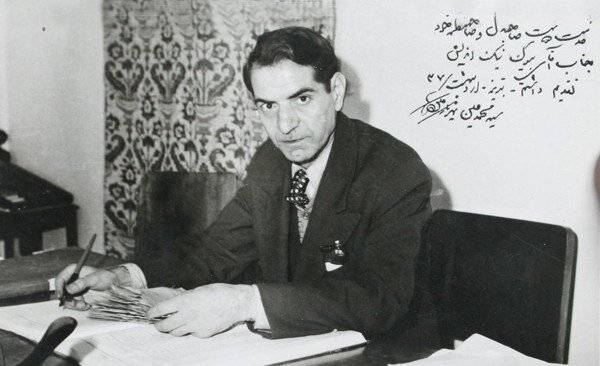The Childhood of Shahriar
Shahriar or Seyyed Mohammad Hossein Behjat Tabrizi , is a famous Iranian poet born in Tabriz in 1906 A.D. He grew up in a large family with five brothers and seven sisters. His father worked as a lawyer and was interested in literature. His mother was also a housewife. He spent his childhood in the heart of nature, in his father’s village, which later inspired his poems.
Shahriar started his education in Tabriz school. His parents and then the late Amir Khizi were among his first teachers, who taught him to read the Quran, the Golestan of Saadi, and the Divan of Hafez. After getting to know Divan of Hafez, Shahriar became interested in poetry and literature. He finished elementary school at Muttahida School and finished Middle school at Ferdowsi School in Tabriz. Then he went to Tehran to continue his education in 1921 A.D and completed his high school education at Dar ul-Funun school. After three years, he entered medical school.
The Shahriar’s Youth
Shahriar fell in love with a girl (Soraya), in his youth and during his medical studies and began a romantic relationship with Soraya for a short time. But their relationship ended due to the girl’s marriage. Shahriar, who was not interested in medicine, gave up on continuing his studies due to the emotional events. At 25, after an unrequited love in 1931 A.D, Shahriar went to Nishapur with the master and famous Iranian painter Kamal Al-Molk and worked in the Document Organization. But a few years later, he returned to Tehran due to his illness, and after finishing his treatment in Tehran, he started to work in the Bank Keshavarzi (Agricultural Bank). In 1953, Shahriar returned to Tabriz after 33 years, and people greeted him with enthusiasm. After living in Tabriz for one year, at the age of 48, he married his cousin’s granddaughter. The fruit of this marriage is two daughters named Shahrzad and Maryam and a son named Hadi.

Shahriar’s Poetic Works and Nickname
Shahriar was a Muslim poet whose you can see spiritual and religious aspects in his poems. He had a sensitive spirit and was known for his humility. Shahriar’s poems focus on human pains, and he has expressed the subject of love in his poetry purer than in any other poem. Shahriar was not only active in poetry and literature, but his artistic spirit also had a hand in all arts, especially in music and calligraphy. When he was young, he played Setar and was so skilled in this field that he made his teacher Abol Hassan Saba’s tears flow. But after some time, he stopped playing Setar and sang for his instrument. Mohammad Hossein Behjat Tabrizi chose the nickname Shiva after immigrating to Tehran, but after a while, he decided to change his nickname. Due to his devotion to Hafez, he took fortune telling from Divan of Hafez twice, and the word “Shahriar” appeared both times; Hence he chose the nickname for himself.
The Theme of Shahriar’s Poems
Most of Shahriar’s poems are in the form of ghazal and include love, heartbreak, separation from a lover, and religion. He retells much moral and educational advice in various poetic formats in his poems. He was also skilled in composing diverse types of Persian poetry, such as Ghazal, Qasida, Masnavi, Rubai, and She’r-e Nimaai. And in a short period, he could provide valuable services to Azerbaijani Persian and Turkish poetry. There is an insult to other folks in his poems, and he was respectful of all languages and nations. His work is in three languages: Azeri, Persian, and Arabic. His first book of poetry was published in 1929 with an introduction by teachers such as Bahar, Saeed Nafisi, and Pejman Bakhtiari, and his last collection of poems was published after his death as the third volume of Divan Shahriar. Divan of Shahriar’s poems contains 120 thousand traditional poems and 15 Free verse and poems in new formats.
A significant part of Shahriar’s Divan is Ghazal. The simplicity and generality of the language make Shahriar’s poetry widespread and popular. We can mention “Ali Ey Homay-e Rahmat” and “Amady Janam Be Ghorbant” among his famous ghazals. Shahriar became famous as a poet of Ahl al-Bayt because of his unique poems praising Amir-Al-Momenin (the first imam of Shiites) and other Shiite imams.
The Poem “Heydar Babaya Salam” by Shahriar
When Shahriar read his Persian poetry to his mother, his mother asked him to write his poems in Azeri so that she would understand. Thus, Shahriar decides to write poetry in his mother tongue. The poem “Heydar Babaya Salam” was published in 1943 as a masterpiece of Azerbaijani literature. In composing this verse, Shahriar was inspired by the national literature of Azerbaijan and depicted his interest in the people of Azerbaijan. The poem is the best literary work in the Turkish-Azeri language, and some musicians, like the famous Armenian composer Hajak, composed a memorable song for it.
Heydar Baba is a mountain near Khvoshganab, Azerbaijan, where Shahriar spent his childhood. In the Heydar Baba collection, he addressed the Mountain and mentioned his childhood memories. When Shahriar’s mother passed away, he wrote a stunning and sad poem called “Oh, my mother” and considered his mother’s death to be the most bitter event in his life. Shahriar fell ill at the age of 81 due to lung disease and finally died at the age of 83. According to his will, he was buried in Maqbarat-o-shoara (one of the historical Mausoleum of Poets of Tabriz). He was the last poet who was buried in the Mausoleum.


